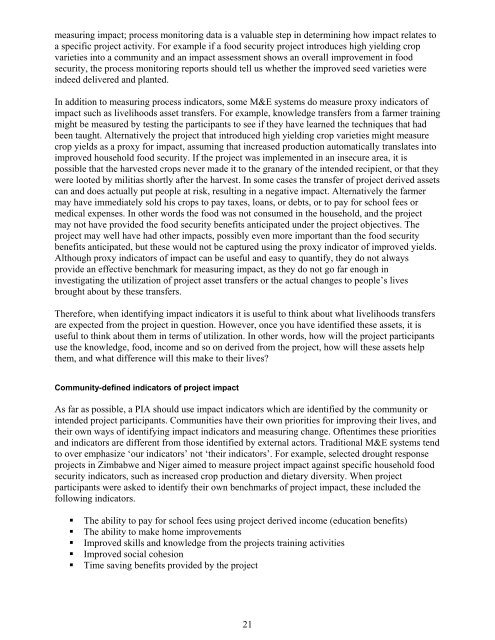Participatory Impact Assessment - Capacity4Dev
Participatory Impact Assessment - Capacity4Dev
Participatory Impact Assessment - Capacity4Dev
Create successful ePaper yourself
Turn your PDF publications into a flip-book with our unique Google optimized e-Paper software.
measuring impact; process monitoring data is a valuable step in determining how impact relates to<br />
a specific project activity. For example if a food security project introduces high yielding crop<br />
varieties into a community and an impact assessment shows an overall improvement in food<br />
security, the process monitoring reports should tell us whether the improved seed varieties were<br />
indeed delivered and planted.<br />
In addition to measuring process indicators, some M&E systems do measure proxy indicators of<br />
impact such as livelihoods asset transfers. For example, knowledge transfers from a farmer training<br />
might be measured by testing the participants to see if they have learned the techniques that had<br />
been taught. Alternatively the project that introduced high yielding crop varieties might measure<br />
crop yields as a proxy for impact, assuming that increased production automatically translates into<br />
improved household food security. If the project was implemented in an insecure area, it is<br />
possible that the harvested crops never made it to the granary of the intended recipient, or that they<br />
were looted by militias shortly after the harvest. In some cases the transfer of project derived assets<br />
can and does actually put people at risk, resulting in a negative impact. Alternatively the farmer<br />
may have immediately sold his crops to pay taxes, loans, or debts, or to pay for school fees or<br />
medical expenses. In other words the food was not consumed in the household, and the project<br />
may not have provided the food security benefits anticipated under the project objectives. The<br />
project may well have had other impacts, possibly even more important than the food security<br />
benefits anticipated, but these would not be captured using the proxy indicator of improved yields.<br />
Although proxy indicators of impact can be useful and easy to quantify, they do not always<br />
provide an effective benchmark for measuring impact, as they do not go far enough in<br />
investigating the utilization of project asset transfers or the actual changes to people’s lives<br />
brought about by these transfers.<br />
Therefore, when identifying impact indicators it is useful to think about what livelihoods transfers<br />
are expected from the project in question. However, once you have identified these assets, it is<br />
useful to think about them in terms of utilization. In other words, how will the project participants<br />
use the knowledge, food, income and so on derived from the project, how will these assets help<br />
them, and what difference will this make to their lives?<br />
Community-defined indicators of project impact<br />
As far as possible, a PIA should use impact indicators which are identified by the community or<br />
intended project participants. Communities have their own priorities for improving their lives, and<br />
their own ways of identifying impact indicators and measuring change. Oftentimes these priorities<br />
and indicators are different from those identified by external actors. Traditional M&E systems tend<br />
to over emphasize ‘our indicators’ not ‘their indicators’. For example, selected drought response<br />
projects in Zimbabwe and Niger aimed to measure project impact against specific household food<br />
security indicators, such as increased crop production and dietary diversity. When project<br />
participants were asked to identify their own benchmarks of project impact, these included the<br />
following indicators.<br />
<br />
<br />
<br />
<br />
<br />
The ability to pay for school fees using project derived income (education benefits)<br />
The ability to make home improvements<br />
Improved skills and knowledge from the projects training activities<br />
Improved social cohesion<br />
Time saving benefits provided by the project<br />
21

















